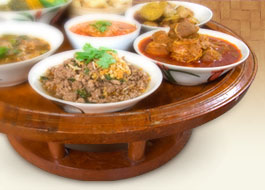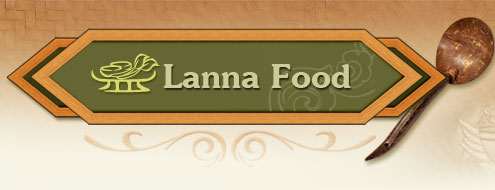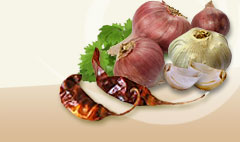Earth star mushroom |
|
|
 | Astraeus Hygrometricus (Pers.) Morg. |
|
| |
 | Lycoperdaceae |
|
| |
 | Barometer earthstars |
|
| |
 | Het thop (Northern), het hiang, het nang, het cok din (Kanchana Diwiset, et al., 2005, p. 243) |
|
| |
 | Cap globose, a little compressed,, blackish, 1.5-3.5 cm., cracked open into 6-8 point star tips when opened with round grayins bag of spores 1-3-3.4 cm. Spores are 7-11 mm. Propagated by spores I the rainy season. (Kanchana Diwiset, et al., 2005, p. 243) Commonly known as wild mushrooms in the North and Northeast of Thailand. (Thawithong Hongwiset, 2004, p. 202) Found in the forests in sandy soil of the forest and dipterocarpus forests in all regions except the South. (Kanchana Diwiset, et al. Comp., 2005, p. 243) |
|
| |
 |

100 gm. contains calcium 40 mg., phosphorus 85 mg., potassium 20 mg. and Vitamin C 12 mg. (Phak Phuen Ban Ahan Thai, 2005, 176) Food: Lanna people add it to soup or stir fried dishes with some tender leaves of tamarind or Chinese laurel. It is best eaten when young, boiled and served with namphrik of all kinds, e.g. namphrik dam, namphrik kha. (Kanchana Diwiset, et al., comp., 2005 243; Thianchai Suthanin, personal communication, June 19, 2007; Phanthira Kanthakalang, personal communication, June 20, 2007) Caution: Another look alike kind, known as het khai hong, is toxic and poisonous. (Kanchana Diwiset, et al., comp., 2005, p. 243) |

It has a cool sweet taste, used as a tonic and to heal internal bruises (Wut Wuthithamwet, 2004, p. 493; Kanchana Diwiset, et al., comp., 2005, p. 243) |
|
| |
 | May-June (Kanchana Diwiset, et al., comp., 2005, p 243) |
|
| |
 |
Kanchana Diwiset, et al., comp. (2005). Phak Phuen Ban Phak Nuea. Phennapha Sapcharoen, ed. (2nd ed.). Nonthaburi: Center for the Development of Traditional Thai Medicines. Thawithong Hongwiwat. (2004). Saranukrom Phak. (2nd ed.). Bangkok: Saengdaet. Phak Phuen Ban Ahan Thai. (2005). Bangkok: Saengdaet. Wut Wuthithamwet, (1997). Saranukrom Samunphria: Ruam Lak Phesatchakam Thai. Bangkok: Odeon Store. |
|
| |
|
|




